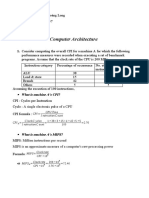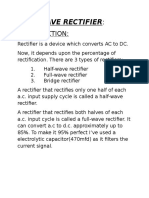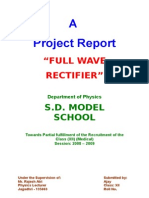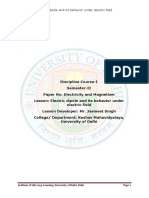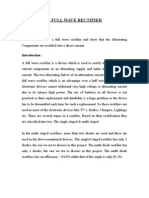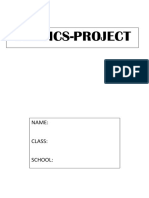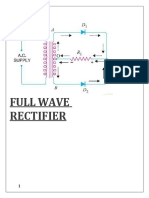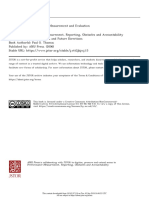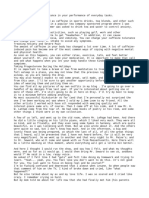Half Wave Rectifier - Circuit Diagram, Theory & Applications
Half Wave Rectifier - Circuit Diagram, Theory & Applications
Uploaded by
muhammad talalCopyright:
Available Formats
Half Wave Rectifier - Circuit Diagram, Theory & Applications
Half Wave Rectifier - Circuit Diagram, Theory & Applications
Uploaded by
muhammad talalOriginal Title
Copyright
Available Formats
Share this document
Did you find this document useful?
Is this content inappropriate?
Copyright:
Available Formats
Half Wave Rectifier - Circuit Diagram, Theory & Applications
Half Wave Rectifier - Circuit Diagram, Theory & Applications
Uploaded by
muhammad talalCopyright:
Available Formats
Half Wave Rectifier – Circuit Diagram, Theory & Applications https://www.electrical4u.
com/half-wave-rectifiers/
Half Wave Rectifier – Circuit Diagram, Theory &
Applications
by Electrical4U
What is a Half Wave Rectifier?
A half wave rectifier is defined as a type of rectifier that only allows one half-cycle of an AC voltage
waveform to pass, blocking the other half-cycle. Half-wave rectifiers are used to convert AC voltage to DC
voltage, and only require a single diode to construct.
A rectifier is a device that converts alternating current (AC) to direct current (DC). It is done by using a
diode or a group of diodes. Half wave rectifiers use one diode, while a full wave rectifier uses multiple
diodes.
The working of a half wave rectifier takes advantage of the fact that diodes only allow current to flow in
one direction.
A half wave rectifier is the simplest form of rectifier available. We will look at a complete half wave
rectifier circuit later – but let’s first understand exactly what this type of rectifier is doing.
The diagram below illustrates the basic principle of a half-wave rectifier. When a standard AC waveform is
passed through a half-wave rectifier, only half of the AC waveform remains. Half-wave rectifiers only
allow one half-cycle (positive or negative half-cycle) of the AC voltage through and will block the other
half-cycle on the DC side, as seen below.
Only one diode is required to construct a half-wave rectifier. In essence, this is all that the half-wave
rectifier is doing.
Since DC systems are designed to have current flowing in a single direction (and constant voltage – which
1 von 9 06.01.2022, 15:46
Half Wave Rectifier – Circuit Diagram, Theory & Applications https://www.electrical4u.com/half-wave-rectifiers/
we’ll describe later), putting an AC waveform with positive and negative cycles through a DC device can
have destructive (and dangerous) consequences. So we use half-wave rectifiers to convert the AC input
power into DC output power.
But the diode is only part of it – a complete half-wave rectifier circuit consists of 3 main parts:
1. A transformer
2. A resistive load
3. A diode
A half wave rectifier circuit diagram looks like this:
We’ll now go through the process of how a half-wave rectifier converts an AC voltage to a DC output.
First, a high AC voltage is applied to the to the primary side of the step-down transformer and we will get
a low voltage at the secondary winding which will be applied to the diode.
During the positive half cycle of the AC voltage, the diode will be forward biased and the current flows
through the diode. During the negative half cycle of the AC voltage, the diode will be reverse biased and
the flow of current will be blocked. The final output voltage waveform on the secondary side (DC) is
shown in figure 3 above.
This can be confusing on first glance – so let’s dig into the theory of this a bit more.
We’ll focus on the secondary side of the circuit. If we replace the secondary transformer coils with a source
voltage, we can simplify the circuit diagram of the half-wave rectifier as:
Now we don’t have the transformer part of the circuit distracting us.
2 von 9 06.01.2022, 15:46
Half Wave Rectifier – Circuit Diagram, Theory & Applications https://www.electrical4u.com/half-wave-rectifiers/
For the positive half cycle of the AC source voltage, the equivalent circuit effectively becomes:
This is because the diode is forward biased, and is hence allowing current to pass through. So we have a
closed circuit.
But for the negative half cycle of the AC source voltage, the equivalent circuit becomes:
Because the diode is now in reverse bias mode, no current is able to pass through it. As such, we now have
an open circuit. Since current can not flow through to the load during this time, the output voltage is equal
to zero.
This all happens very quickly – since an AC waveform will oscillate between positive and negative many
times each second (depending on the frequency).
Here’s what the half wave rectifier waveform looks like on the input side (Vin), and what it looks like on
the output side (Vout) after rectification (i.e. conversion from AC to DC):
3 von 9 06.01.2022, 15:46
Half Wave Rectifier – Circuit Diagram, Theory & Applications https://www.electrical4u.com/half-wave-rectifiers/
The graph above actually shows a positive half wave rectifier. This is a half-wave rectifier which only
allows the positive half-cycles through the diode, and blocks the negative half-cycle.
The voltage waveform before and after a positive half wave rectifier is shown in figure 4 below.
Conversely, a negative half-wave rectifier will only allow negative half-cycles through the diode and will
block the positive half-cycle. The only difference between a posive and negative half wave rectifier is the
direction of the diode.
As you can see in figure 5 below, the diode is now in the opposite direction. Hence the diode will now be
forward biased only when the AC waveform is in its negative half cycle.
Half Wave Rectifier Capacitor Filter
The output waveform we have obtained from the theory above is a pulsating DC waveform. This is what is
obtained when using a half wave rectifier without a filter.
4 von 9 06.01.2022, 15:46
Half Wave Rectifier – Circuit Diagram, Theory & Applications https://www.electrical4u.com/half-wave-rectifiers/
Filters are components used to convert (smoothen) pulsating DC waveforms into constant DC waveforms.
They achieve this by suppressing the DC ripples in the waveform.
Although half-wave rectifiers without filters are theoretically possible, they can’t be used for any practical
applications. As DC equipment requires a constant waveform, we need to ‘smooth out’ this pulsating
waveform for it to be any use in the real world.
This is why in reality we use half wave rectifiers with a filter. A capacitor or an inductor can be used as a
filter – but half wave rectifier with capacitor filter is most commonly used.
The circuit diagram below shows how a capacitive filter is can be used to smoothen out a pulsating DC
waveform into a constant DC waveform.
Half Wave Rectifier Formula
We will now derive the various formulas for a half wave rectifier based on the preceding theory and graphs
above.
Ripple Factor of Half Wave Rectifier
‘Ripple’ is the unwanted AC component remaining when converting the AC voltage waveform into a DC
waveform. Even though we try out best to remove all AC components, there is still some small amount left
on the output side which pulsates the DC waveform. This undesirable AC component is called ‘ripple’.
To quantify how well the half-wave rectifier can convert the AC voltage into DC voltage, we use what is
known as the ripple factor (represented by γ or r). The ripple factor is the ratio between the RMS value of
the AC voltage (on the input side) and the DC voltage (on the output side) of the rectifier.
The formula for ripple factor is:
Which can also be rearranged to equal:
The ripple factor of half wave rectifier is equal to 1.21 (i.e. γ = 1.21).
Note that for us to construct a good rectifier, we want to keep the ripple factor as low as possible. This is
why we use capacitors and inductors as filters to reduce the ripples in the circuit.
Efficiency of Half Wave Rectifier
Rectifier efficiency (η) is the ratio between the output DC power and the input AC power. The formula for
the efficiency is equal to:
The efficiency of a half wave rectifier is equal to 40.6% (i.e. ηmax = 40.6%)
5 von 9 06.01.2022, 15:46
Half Wave Rectifier – Circuit Diagram, Theory & Applications https://www.electrical4u.com/half-wave-rectifiers/
RMS value of Half Wave Rectifier
To derive the RMS value of half wave rectifier, we need to calculate the current across the load. If the
instantaneous load current is equal to iL = Imsinωt, then the average of load current (IDC) is equal to:
Where Im is equal to the peak instantaneous current across the load (Imax). Hence the output DC current
(IDC) obtained across the load is:
For a half-wave rectifier, the RMS load current (Irms) is equal to the average current (IDC) multiple by
π/2. Hence the RMS value of the load current (Irms) for a half wave rectifier is:
Where Im= Imax which is equal to the peak instantaneous current across the load.
Peak Inverse Voltage of Half Wave Rectifier
Peak Inverse Voltage (PIV) is the maximum voltage that the diode can withstand during reverse bias
condition. If a voltage is applied more than the PIV, the diode will be destroyed.
Form Factor of Half Wave Rectifier
Form factor (F.F) is the ratio between RMS value and average value, as shown in the formula below:
The form factor of a half wave rectifier is equal to 1.57 (i.e. F.F= 1.57).
Output DC Voltage
The output voltage (VDC) across the load resistor is denoted by:
Applications of Half Wave Rectifier
Half wave rectifiers are not as commonly used as full-wave rectifiers. Despite this, they still have some
uses:
• For rectification applications
• For signal demodulation applications
• For signal peak applications
Advantages of Half Wave Rectifier
The main advantage of half-wave rectifiers is in their simplicity. As they don’t require as many
components, they are simpler and cheaper to setup and construct.
As such, the main advantages of half-wave rectifiers are:
• Simple (lower number of components)
• Cheaper up front cost (as their is less equipment. Although there is a higher cost over time due to
increased power losses)
Disadvantages of Half Wave Rectifier
6 von 9 06.01.2022, 15:46
Half Wave Rectifier – Circuit Diagram, Theory & Applications https://www.electrical4u.com/half-wave-rectifiers/
The disadvantages of half-wave rectifiers are:
• They only allow a half-cycle through per sinewave, and the other half-cycle is wasted. This leads to
power loss.
• They produces a low output voltage.
• The output current we obtain is not purely DC, and it still contains a lot of ripple (i.e. it has a high
ripple factor)
3 Phase Half Wave Rectifier
All of the theory above has dealt with a single phase half wave rectifier. Although the principle of a 3 phase
half wave rectifier is the same, the characteristics are different. The waveform, ripple factor, efficiency,
and RMS output values are not the same.
The three-phase half wave rectifier is used for the conversion of three phase AC power to DC power. Here
the switches are diodes, and hence they are uncontrolled switches. That is to say, there is no way of
controlling the on and off times of these switches.
The 3 phase half wave diode rectifier is generally constructed with a three-phase supply connected to a
three-phase transformer where the secondary winding of the transformer is always connected via star
connection. This is because the neutral point is required to connect the load back to the transformer
secondary windings, providing a return path for the flow of power.
A typical configuration of a three-phase half wave rectifier supplying a purely resistive load is shown
below. Here, each phase of the transformer is considered as an individual alternating source. The
simulation and measurement of voltages are as shown in the circuit below. Here we have connected an
individual voltmeter across each source as well as across the load.
The three-phase voltages are shown below.
7 von 9 06.01.2022, 15:46
Half Wave Rectifier – Circuit Diagram, Theory & Applications https://www.electrical4u.com/half-wave-rectifiers/
The voltage across the resistive load is shown below. The voltage is shown in black.
So we can see from the above figure that the diode D1 conducts when the R phase has a value of thevoltage
that is higher than the value of the voltage of the other two phases,and this condition begins when the R
phase is at a 30o and repeats after every complete cycle. That is to say, the next time diode DI begins to
conduct is at 390o. Diode D2 takes over conduction from D1 which stops conducting at angle 150o because
at this instant the value of voltage in B phase becomes higher than the voltages in the other two phases. So
each diode conducts for an angle of 150o – 30o = 120o.
Here, the waveform of the resulting DC voltage signal is not purely DC as it is not flat,but rather it
contains a ripple. And the frequency of the ripple is 3 × 50 = 150 Hz.
The average of the output voltage across the resistive load is given by
8 von 9 06.01.2022, 15:46
Half Wave Rectifier – Circuit Diagram, Theory & Applications https://www.electrical4u.com/half-wave-rectifiers/
Where,
The RMS value of the output voltage is given by
The ripple voltage is equal to,
And the voltage ripple factor is equal to,
The equation above shows that the voltage ripple is significant. This is undesirable as this leads to
unnecessary power loss.
DC output power,
AC input power,
Efficiency,
Even though the efficiency of the 3 phase half-wave rectifier is seemingly high, it is still less than the
efficiency provided by a 3 phase full wave diode rectifier. Although three phase half wave rectifiers are
cheaper, this cost saving is insignificant compared to the money lost in their higher power losses. As such,
three-phase half-wave rectifiers are not commonly used in industry.
9 von 9 06.01.2022, 15:46
You might also like
- Ia - Smaw - Prepare Weld Materials PDFDocument36 pagesIa - Smaw - Prepare Weld Materials PDFJanus Salinas85% (20)
- Case - Auto AssemblyDocument3 pagesCase - Auto Assemblychetan203No ratings yet
- Igcse ChemistryDocument33 pagesIgcse ChemistryAykhan DadashovNo ratings yet
- Excavations QuizDocument12 pagesExcavations QuizMax McguireNo ratings yet
- Book of Textile EngineeringDocument122 pagesBook of Textile EngineeringJuan Cubas0% (1)
- Computer Component Performance-Nguyễn Hoàng Long - BI11-157Document9 pagesComputer Component Performance-Nguyễn Hoàng Long - BI11-157Long Nguyễn100% (1)
- Physics ProjectDocument11 pagesPhysics ProjectBoves AlexNo ratings yet
- Full Wave Bridge RectifierDocument8 pagesFull Wave Bridge RectifierPurabi DasNo ratings yet
- Half Wave RectifierDocument15 pagesHalf Wave RectifierIshan Kavdia100% (2)
- Project On Full Wave RectifierDocument16 pagesProject On Full Wave RectifierTiasa BanerjeeNo ratings yet
- Full Wave RectifierDocument6 pagesFull Wave RectifierAtul Namdeo0% (1)
- PROJECT - PhysicsDocument8 pagesPROJECT - PhysicsAtul TiwariNo ratings yet
- Physics Project WorkDocument15 pagesPhysics Project WorkSidhant KaushikNo ratings yet
- Half Wave RectifierDocument6 pagesHalf Wave RectifierAnmol Dubey33% (3)
- Half Wave RectifierDocument9 pagesHalf Wave RectifierAtul Namdeo100% (1)
- Physics Investigatory ProjectDocument14 pagesPhysics Investigatory ProjectAkshat GoelNo ratings yet
- Phy Project FileDocument16 pagesPhy Project FileCadever Y.T100% (1)
- Full Wave Rectifier Class 12 Project ReportDocument5 pagesFull Wave Rectifier Class 12 Project ReportSaurav Kar75% (4)
- Full Wave RectifierDocument15 pagesFull Wave Rectifiermandeep singhNo ratings yet
- Physics Project Full Wave RectifierDocument12 pagesPhysics Project Full Wave RectifierHarsh50% (6)
- Physics ProjectDocument16 pagesPhysics ProjectAnimesh KhaNo ratings yet
- Full Wave RectifierDocument14 pagesFull Wave RectifierCYBER HUTNo ratings yet
- Full Wave Rectifier Project PDFDocument17 pagesFull Wave Rectifier Project PDFApoorva Panchal100% (7)
- PHISICSDocument13 pagesPHISICSHimanshu DiwanNo ratings yet
- Class-12-Physics-Project-On-Full-Wave-Bridge-Rectifier HELLO123Document16 pagesClass-12-Physics-Project-On-Full-Wave-Bridge-Rectifier HELLO123Aryan Budhathoki100% (1)
- Physics Project ON: Full Wave RectifierDocument11 pagesPhysics Project ON: Full Wave RectifierkartikNo ratings yet
- Jasleen - Physics Investigatory ProjectDocument17 pagesJasleen - Physics Investigatory ProjectDaily Meme DOSENo ratings yet
- PhysicsDocument13 pagesPhysics42,Vansh 8th DNo ratings yet
- EXPERIMENT 1 - Diode As RectifierDocument5 pagesEXPERIMENT 1 - Diode As RectifierSamNo ratings yet
- Physics Project On Capacitor .Document23 pagesPhysics Project On Capacitor .Your Friend Madhur SharmaNo ratings yet
- Class 12 Physics Project - Measuring Current Using Halfwave RectifierDocument19 pagesClass 12 Physics Project - Measuring Current Using Halfwave RectifierSarthak GoelNo ratings yet
- Ilovepdf MergedDocument9 pagesIlovepdf MergedKumar PrinceNo ratings yet
- Physics Investigatory ProjectDocument14 pagesPhysics Investigatory ProjectRitvik JoshiNo ratings yet
- CONCLUSIONDocument1 pageCONCLUSIONTiasa BanerjeeNo ratings yet
- Full Wave RectifierDocument15 pagesFull Wave RectifierHarsh Narula80% (5)
- Half Wave Rectifier MAIN 1Document13 pagesHalf Wave Rectifier MAIN 1Akshat Sharma100% (2)
- Revised Full Wave RectifierDocument28 pagesRevised Full Wave RectifierSiddhartha SatyakamaNo ratings yet
- Full Wave Rectifier (Physics)Document33 pagesFull Wave Rectifier (Physics)Sahil Sethi45% (20)
- Investigatory Project by Divyam GiriDocument23 pagesInvestigatory Project by Divyam GiriPriyanshu GiriNo ratings yet
- Physics Project Class 12Document10 pagesPhysics Project Class 12Pratik Punj75% (4)
- Physics ProjectDocument20 pagesPhysics ProjectJai BansalNo ratings yet
- Physics Investigatory Project: Half Wave and Full Wave RectifierDocument15 pagesPhysics Investigatory Project: Half Wave and Full Wave RectifierRitvikTiwariNo ratings yet
- KVS Physics ProjectDocument11 pagesKVS Physics ProjectLokesh MaliNo ratings yet
- Physics Investigatory Project: M.B.S Public SchoolDocument22 pagesPhysics Investigatory Project: M.B.S Public SchoolPEEYUSH YADAVNo ratings yet
- Practical Viva Questions For Puc 2 - 2022Document4 pagesPractical Viva Questions For Puc 2 - 2022Manu ShreeNo ratings yet
- A Full Wave RectifierDocument14 pagesA Full Wave RectifierVarun Jain50% (6)
- Physics Investigatory Project Class 12thDocument21 pagesPhysics Investigatory Project Class 12thAyaan Raza KhanNo ratings yet
- Full Wave RectifierDocument16 pagesFull Wave RectifierAnubhav Malik100% (1)
- Physics Investigatory Project: by Tarun Singh of XII B, Manav Rachna International SchoolDocument11 pagesPhysics Investigatory Project: by Tarun Singh of XII B, Manav Rachna International Schoolraj60% (5)
- PN JunctionDocument10 pagesPN Junctionasdxws feNo ratings yet
- Electric Dipole and Its Behavior Under Electric FieldDocument16 pagesElectric Dipole and Its Behavior Under Electric FieldsNo ratings yet
- Physics Project Class 12 On RectifierDocument14 pagesPhysics Project Class 12 On RectifierShubham BhaskarNo ratings yet
- A Full Wave RectifierDocument11 pagesA Full Wave Rectifierapi-383157278% (73)
- Full Wave RectifierDocument10 pagesFull Wave Rectifierdheerajguptaandro20% (5)
- Physics Investigatory Project HesDocument21 pagesPhysics Investigatory Project HesBk ShreyaNo ratings yet
- Class 12 Physics Project On Full Wave Bridge RectifierDocument15 pagesClass 12 Physics Project On Full Wave Bridge Rectifierkeshav AgarwalNo ratings yet
- Rectifier ReportDocument9 pagesRectifier ReportMogambo DonNo ratings yet
- PHYSICS INVESTIGATORY PROJECT Step DownDocument23 pagesPHYSICS INVESTIGATORY PROJECT Step DownRajni Vishwakarma100% (1)
- Physics Activity 1 To 6Document12 pagesPhysics Activity 1 To 6Aadit “ThePROkiller”0% (1)
- Unit-I Pn-Junction DiodeDocument48 pagesUnit-I Pn-Junction DiodeBabu GundlapallyNo ratings yet
- Half Wave RectifierDocument8 pagesHalf Wave Rectifierropef82117No ratings yet
- Full Wave Bridge RectifierDocument8 pagesFull Wave Bridge RectifierAnonimen Anonimen100% (1)
- Full Wave RectifierDocument17 pagesFull Wave RectifierDhana sekaranNo ratings yet
- Physics Project FileDocument17 pagesPhysics Project FileDhana sekaranNo ratings yet
- Physics ReportDocument22 pagesPhysics Reportparam9210340No ratings yet
- Adobe Scan 04 Nov 2024Document18 pagesAdobe Scan 04 Nov 2024hagalagila12No ratings yet
- IT Security and SafetyDocument11 pagesIT Security and SafetyRosy Gaby EstudilloNo ratings yet
- Performance Measurement and EvaluationDocument3 pagesPerformance Measurement and EvaluationSumudu SamarasingheNo ratings yet
- Sari Suhaedi (2016)Document8 pagesSari Suhaedi (2016)miiracletsNo ratings yet
- Air Heater Process Data Sheet: Design Conditions Shell SideDocument4 pagesAir Heater Process Data Sheet: Design Conditions Shell SideAnonymous tDeb8M0SyNo ratings yet
- PAB-Class of Test Structure - Biological Testing Rev. 02 PDFDocument11 pagesPAB-Class of Test Structure - Biological Testing Rev. 02 PDFBernardoNo ratings yet
- Folklore of The Freeway - Eric AvilaDocument256 pagesFolklore of The Freeway - Eric AvilaJuno IantoNo ratings yet
- GIS 12-205-Synchronous Motors (IEC)Document16 pagesGIS 12-205-Synchronous Motors (IEC)ballasreedharNo ratings yet
- CidamDocument3 pagesCidamCharrie Molinas Dela PeñaNo ratings yet
- Features of 80186, 80286, 80386, 80486 and Pentium Family ProcessorsDocument32 pagesFeatures of 80186, 80286, 80386, 80486 and Pentium Family ProcessorsRahul SinghNo ratings yet
- DerivativesDocument3 pagesDerivativesAditya SukhijaNo ratings yet
- ASPEC Safe Operation of Camera CranesDocument28 pagesASPEC Safe Operation of Camera CranesM. GuidoNo ratings yet
- Electron Beam EvaporationDocument27 pagesElectron Beam EvaporationS shek DhavudNo ratings yet
- ACW Leaders List 01Document29 pagesACW Leaders List 01gomguiNo ratings yet
- Economic Importance of AlgaeDocument9 pagesEconomic Importance of Algaepshantanu123No ratings yet
- Adaptive ReuseDocument7 pagesAdaptive ReusemadhurjyaarchnehNo ratings yet
- Module-3 2Document6 pagesModule-3 2Chckn ThiccNo ratings yet
- PDF Resize PDFDocument2 pagesPDF Resize PDFUsmanNo ratings yet
- Planning and Design of Parking at MANIT Bhopal (NIT-Bhopal) CampusDocument63 pagesPlanning and Design of Parking at MANIT Bhopal (NIT-Bhopal) CampusNirdosh MatreNo ratings yet
- FIN240 Questions 1Document5 pagesFIN240 Questions 1Robin HexNo ratings yet
- REACH 2025 - MENA ICT Forum - Opening Presentation Nov 08 - 16 - FINAL VersionDocument28 pagesREACH 2025 - MENA ICT Forum - Opening Presentation Nov 08 - 16 - FINAL VersionMelina Al-HasanNo ratings yet
- A7rV Help GuideDocument535 pagesA7rV Help Guidesonyalpharumors100% (2)
- RF M E Smith Chart Is To Be Provided Answer All Questions PART A: ( × )Document2 pagesRF M E Smith Chart Is To Be Provided Answer All Questions PART A: ( × )sharonfranklinNo ratings yet
- DH 1208Document12 pagesDH 1208The Delphos HeraldNo ratings yet
- Employee Provident Funds and Miscellaneous Provision Act 1952Document5 pagesEmployee Provident Funds and Miscellaneous Provision Act 1952Tanver ShaikhNo ratings yet





